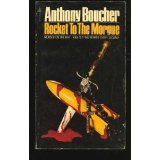Heinlein Society – Scholastic/Academic articles
ROBERT A. HEINLEIN: MURDER SUSPECT
examining Rocket to the Morgue by Anthony Boucher
This is copyrighted material and may not be copied or reproduced in any form, including on other websites, without permission of the copyright holder.
ROBERT A. HEINLEIN:
MURDER SUSPECT
by D. A. Houdek
and
G. E. Rule
©1996 D. A. Houdek & G. E. Rule
(originally published in The Galactic Citizen, Issue 12, Spring 1996)
Los Angeles, California, a Saturday evening in 1941, at a meeting of the Mañana Literary Society…
The menagerie was meager this evening. In the large living-room were only five men. The tall thin one established in the heavy chair under the reading-lamp Marshall rightly took for his host… One was an open-faced youth who might well be a college sophomore. 1
And Anson MacDonald and Lyle Monroe may stop by.
This was the scene which Detective Lieutenant, Homicide, Terence Marshall entered at the home of famed science fiction author Austin Carter, a.k.a. Robert Heinlein. There had been a murder, and an attempted murder, tied to the publishing world with the clues pointing toward the writers who met at a house in Laurel Canyon and called themselves the Mañana Literary Society.
The Mañana Literary Society was a group of well-known, and soon-to-be well-known, writers in the early 1940s who met at the home of relative newcomer Robert Heinlein to discuss the science fiction stories they would be writing “mañana”. They drank, “mostly cheap white sherry… told shaggy dog stories and recited dirty limericks and talked about science fiction and life in the future and sex and nearly everything.” 2

Copies of Rocket to the Morgue by Anthony Boucher can be found at Amazon.com or from the booksellers at Abebooks
In his 1942 novel “Rocket to the Morgue”, Anthony Boucher captured this moment in science fiction history and preserved it by using his friends and fellow members of the Mañana Literary Society as the suspects in a murder mystery. Jack Williamson identifies the characters in the book as Robert Heinlein playing Austin Carter, a chief suspect, and the founder of the Mañana Literary Society. L. Ron Hubbard is D. Vance Wimpole, a garrulous charmer of dubious integrity. John Campbell plays the role of Don Stuart (the pen name he used for much of his fiction, including the classic “Who Goes There?”, the basis for the movie THE THING), and Jack Williamson and Ed Hamilton are combined into Joe Henderson,3 whom Boucher describes as a “reticent, love-starved creator of star-roving Captain Comet, hero of pulp science fiction.” 4
As a mystery novel, “Rocket to the Morgue” falls a bit short. There are too many characters for a book of this length, and the pacing sometimes drags. References to previous Boucher mysteries, and the presence of a mystery-solving nun (why do so many nuns solve mysteries?), create confusion. The book does provide a classic locked-room mystery which allows the Carter/Heinlein character to offer some science fiction solutions to the question of how the murderer got out of the room: “A, he never got out because he never was there. The dagger was conveyed through space and plunged into the victim’s heart by teleportation… B, the murder disassembled his component atoms on one side of the wall, filtered through by osmosis, and reassembled them on the other side. …C, and far more likely, the murderer simply entered and left through the fourth dimension of space.” 5
To most readers these may be taken as flippant science fictional answers by the author/suspect to the police detective. Heinlein fans can take the discussion by Carter/Heinlein of the nature of fourth dimensional space a step further by remembering the story “-And He Built a Crooked House-“, printed in Astounding Science Fiction in March of 1941 – about the time Boucher was writing “Rocket to the Morgue.” It is easy to imagine the Society’s discussions of the fourth dimension leading in part to both stories. Also, the first few paragraphs of “-And He Built a Crooked House-” describe the area and home of Heinlein in the early ’40s.
If you are interested, they will drive you up Laurel Canyon “- Where we keep the violent cases.” The Canyonites – the brown-legged women, the trunks-clad men constantly busy building and rebuilding their slap-happy unfinished homes… 6
It’s also of interest to see Heinlein and his science fiction friends in their natural habitat. Mrs. Carter refers to her husband (Carter/Heinlein) as “holding forth.” In the scene that follows Carter is lecturing his guests on the nature of science fiction. The words and flavor of the scene are so purely “Heinlein” that one could easily imagine them flowing from Heinlein’s own mouth, or from his typewriter through the voice of one of his characters.
The Austin Carter/Heinlein character came across as one of the most well-rounded in the novel, and utterly true to my perception of what Heinlein was like in person. Boucher in “Rocket to the Morgue” gives later readers a time-machine glimpse into Robert Heinlein’s own living-room, hearing him speak – more or less – as himself. Often it has been said that some of Heinlein’s characters, Lazarus Long in particular, are Heinlein in a very thin disguise. The characterization Anthony Boucher gave of his friend put me most strongly in mind of Jubal Harshaw from “Stranger in a Strange Land,” with a hint of Hugh Farnham from “Farnham’s Freehold” thrown in.
Rocket also provides a unique contemporary glimpse of Pre-WWII Heinlein politics, as Heinlein scholar Tom Perry has examined in depth elsewhere.7 Knowing that Heinlein ran as an EPICrat (the name given leftist Democrats supporting Upton Sinclair’s EPIC -End Poverty In California- platform) in his unsuccessful 1938 campaign for the California Assembly makes this “Austin Carter” tidbit especially interesting:
I’m writing about a world in which Upton Sinclair won the EPIC campaign here in California, but Landon beat Roosevelt in ’36. As a result California drifts more to the left and the nation to the extreme right until there is civil war, ending in the establishment on the west coast of the first English-speaking socialist republic.8
The other characters as representations of real people were less clear and fleshed-out. As well as the science fiction writers of the day, Boucher incorporates some sf fans into the book, making one prominent fan a murder victim. His images of these early fans, or proto-fen, are convincing, though not flattering. Boucher notes, “This in the way it was in Southern California just before the war, when science fiction was being given its present form by such authors as Robert A. Heinlein (still the undisputed Master), Cleve Cartmill, Jack Williamson, Edmond Hamilton, Henry Kuttner, C. L. Moore, and many others.” 9 Jack Williamson names some of these “others” including Ray Bradbury, but, “…he was still so brash and noisy that Leslyn didn’t always want him” 10
Which brings us to another interesting feature of the novel. Mrs. Carter, the character representing Mrs. Heinlein, is Mrs. Leslyn Heinlein, Robert Heinlein’s first wife [revision note 05.25.03: Actually Heinlein was briefly married in the 1920s before Leslyn, so Leslyn McDonald Heinlein was his second wife]. There are references to her also being a writer, an unknown factor where the real Leslyn Heinlein is concerned.
The view of Heinlein as an author at work creates one of the most fun scenes in the book. He works in an office whose door is labeled:
! ! ! DANGER ! ! !
NITROSYNCRETIC LABORATORY
! KEEP OUT !
As well as getting to see what Heinlein must have been like when he was at work on his writing, we get a chance to see him mercilessly baiting the police detective who has come to question him about the murders.
While “Rocket to the Morgue” may not be the best mystery you’ll ever read, it is an intriguing look into the beginnings of science fiction as we know it today. Ironically enough, since this book was published & marketed as a mystery, and under another Boucher pen name, many sf fans would have never heard of it, and most mystery fans would not know enough to recognize the thinly disguised sf authors. But if the mystery fans of 1942 got an only so-so example of their favorite genre, at least latter day sf fen have a unique opportunity to see “the old masters” back when sf was young.
NOTES: Anthony Boucher’s real name was William Anthony Parker White. He wrote, and originally published “Rocket to the Morgue” under the name H. H. Holmes. He was one of the founding editors of The Magazine of Fantasy and Science Fiction, and author of numerous novels of mystery and science fiction.
1,4,5,8,9 Rocket to the Morgue by Anthony Boucher, ©1942
2,3,10 Wonder’s Child: My Life in Science Fiction by Jack Williamson, ©1984
6 -And He Built a Crooked House- by Robert A. Heinlein, ©1941
7 Ham and Eggs and Heinlein by Tom Perry, Monad #3, 1993



